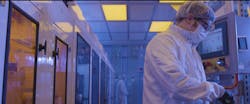Q&A: Reducing energy losses through smart windows
Smart-window technology firm Crown Electrokinetics recently launched its first product, the Smart Window Insert, which transitions from clear to dark in seconds, and can be cost-effectively retrofitted into existing office buildings. According to the company, initial field tests of the product show a 26% reduction in HVAC energy usage and associated carbon emissions.
Crown further reports that the company just signed a master supply agreement with Hudson Pacific Properties, a major West Coast REIT that serves tenants in the tech and media sectors (i.e. Google, Netfix, Uber and Square among others).
Smart Buildings Technology had some questions for Crown’s CEO Doug Croxall on the challenges of reducing energy losses through smart windows, and how Crown and Hudson Pacific have teamed to accelerate the deployment of this technology across the entire real estate sector. Croxall wanted to talk about how the technology is being received in his discussions with other large REITs, in addition to Hudson.
SBT: What are the main challenges of reducing energy losses through smart windows?
Crown Electrokinetics CEO Doug Croxal: The main challenge for smart windows has always been cost. Historically, smart window technologies have struggled to find customers because they are expensive to make and expensive to install.
Electrochromic technology, for example, typically requires the total replacement of the window, and it has to be hardwired into the building’s electrical system. That really limits those technologies to new construction and major window replacement projects, and even then, only a limited customer set has committed to such offerings.
Crown’s Smart Window Insert, which is designed to transition from clear to dark in seconds, changes the past narrative. It will be cost-effectively retrofitted into existing buildings, with minimal disruption for building owners and tenants.
That’s a game changer for reducing energy usage, utility bills and carbon emissions from commercial office buildings. Windows are the weakest link in a building’s thermal systems, letting in too much heat in summer and letting too much heat escape in winter. Roughly 30% of the energy used for HVAC in buildings is currently wasted because of this heat transfer, so making windows smarter and more energy efficient can help save money and accelerate the transition to net-zero carbon at the same time.
How have Crown and Hudson Pacific teamed to accelerate the deployment of this technology across the entire real estate sector?
In two principal ways: 1) Our technology was originally developed by Hewlett Packard for a different purpose – screens and displays in the electronics sector. Turning that technology into a smart-window product for the building sector is a big challenge and input from Hudson Pacific and other potential customers in the commercial real estate sector has really helped us understand how the product needs to perform.
And 2) Hudson Pacific is also a leader on sustainability and climate issues in the real estate sector. The Hudson Pacific team has been very open and collaborative with other real estate investment trusts, or REITs, in discussing their work with Crown on this technology. Sustainability, climate change, and reducing carbon emissions are common issues of concern for the whole real estate sector, not just individual REITs.
How specifically is Crown’s Smart Window Insert installed and maintained?
The Smart Window Insert is designed for easy retrofitting. It’s built to the size of the existing window frame, so it just snaps into place without the need for any screws or fasteners. It can be installed overnight or during a weekend, so there’s no interruption for your tenants.
Our Smart Window Inserts are also designed to be fully self contained, meaning they do not need to be hardwired into the building's electrical grid. The electrokinetic film requires very low energy to operate, so each Smart Window Insert is equipped with a thin solar strip and a small lithium-ion battery seamlessly built into the frame.
How is Crown’s technology being received in its discussions with other large REITs, in addition to Hudson?
The response from other large REITs has generally been very similar to what we experienced with Hudson Pacific: They’re really excited about the potential of this technology and they want to see it deployed across the real estate sector.
I think climate change is such a big challenge that many big real estate firms are looking to work together where they can on the problems they have in common. The inefficiency of existing windows is definitely one of those problems. So is the prohibitively high cost of various smart-glass products that have been pitched to the real estate sector over the years.
As we talk to potential customers about Smart Window Inserts, however, their initial skepticism about anything called smart glass soon gives way to genuine interest and excitement. This is something new: A retrofit technology, designed to turn existing windows into smart windows, with a quick and affordable installation process. It’s the kind of solution they had been hoping for, but have not seen before.

